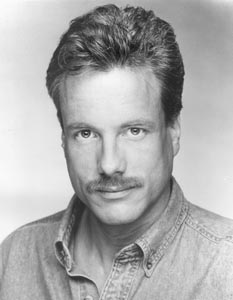![[Metroactive Stage]](/stage/gifs/stage468.gif)
[ Stage Index | San Jose | Metroactive Central | Archives ]
The Singing 'Nutcracker'
If the ballet can do it, why can't Opera San José?
By Scott MacClelland
THANKS TO PAUL HINDEMITH, a goldsmith sings as he plots to murder his customers. Thanks to Jacques Offenbach, a wind-up doll seduces a young man with her song. Thanks to Craig Bohmler, a singing nutcracker nearly pushes a young girl into virtual autism. In each of these three cases, the composer found inspiration in the pages of E.T.A. Hoffmann, the German author and artist (and a composer himself) who cashed in on the early-19th-century appetite for fantasy and fright.
But how does Hoffmann's nutcracker menace the young girl, and anyway, when did it ever sing? Answers to these and other burning questions will be revealed in Opera San José's world premiere production of Bohmler's The Tale of the Nutcracker, opening this Saturday at the Montgomery Theater. One answer doesn't even need a question. Since dance companies everywhere depend on the famous Tchaikovsky ballet to finance entire seasons, opera companies might see comparable results from a similarly inspired surefire hit.
Of course, such a success remains to be seen. But Bohmler at least has a track record, the most significant elements being the repeated revivals several of his theater works have enjoyed. His collaboration with lyricist Marion Adler, Gunmetal Blues, has now seen some 60 productions in the U.S. and Canada.
While Bohmler is no stranger to San Jose (he coaches Opera San José, has performed several times with the San Jose Chamber Orchestra and works with the American Musical Theatre, San Jose Repertory Theatre and Citiarts Theater), his compositions have been commissioned by and performed in venues in Europe and Canada, as well as by musical theaters and opera companies in Texas, Arizona, Tennessee and Southern California.
His Enter the Guardsman was staged by Andrew Lloyd Webber's company in London's West End and attracted an Olivier Award nomination for best musical. (It got its U.S. premiere at the New Jersey Shakespeare Festival barely two months ago.) His The Achilles Heel, commissioned and created by the Houston Grand Opera, took a prize at the National Opera Association competition.
"David Gockley at Houston Grand asked me to write Achilles for a high school audience, a tough crowd," Bohmler says. "I was drawn to Nutcracker because it also represents a rite of passage. I'm still a kind of teenager."
For the San Jose premiere, Bohmler teamed with Daniel Helfgot, Opera San José's resident stage director, whose résumé includes more than 150 productions staged in his native Argentina and in Mexico, Canada, Virginia, Maryland, Tennessee, Pennsylvania, Oregon, Utah and San Francisco.
Bohmler is quick to praise Helfgot, saying, "The libretto, the book, is very important to me. Since we both love The Tales of Hoffmann, we opted to begin with a prologue with Uncle Drosselmeier in his toy shop, carving a nutcracker for his young friend Marie. He calls for dream spirits to guide her through the life passage that lies ahead. He observes, 'Little girls will dream of love, the magic of love, but she's in danger of being lost in those dreams, her waking thoughts consumed through her dreams.' He says to the nutcracker, 'I have plans for you, little boy.' "
BOHMLER EXPLAINS that in the popular ballet, the story line of Act I gives way to a divertissement of dances in Act II. Therefore a narrative second act had to be created for the opera. The figure of a grandfather clock not only symbolizes time itself but also becomes the point of entry into a dream world, the portal through which the necessary rite of passage must take place. Like Alice's looking glass, the clock tempts Marie (Clara, as George Balanchine chose to call her) with adventures of discovery and, as it turns out, unexpected danger.
"I don't want Drosselmeier to be anything but dark and mysterious," Bohmler adds. "He is not a menace himself. Marie feels abiding affection for Uncle Drossy. I don't want to give too much away, but it might be useful to look for a story within a story within a story."
The musical influences that refract through Bohmler's lens range from Wagner to Berg, Barber and Prokofiev, "plus the inventiveness of Sondheim and economy of Britten." (As an accomplished concert pianist, he adores Chopin.)
"I don't think operas and musical theater are very far apart," he asserts. "I write for the singing theater. The scene where Marie meets the nutcracker--a prince in the dream--is very much influenced by Philip Glass; two chords alternate for about five minutes, because this is the land where time stops."
Bohmler is not afraid of using time-tested musical conventions to make his narrative clear. In Nutcracker, "Every character has a leitmotif, a musical signature. And I like to write 'scene and aria,' trios, duets. I think that's why I have second productions of my work."
Finally, Bohmler warms to the greatest compliment he has enjoyed at Opera San José: "The singers have loved this process. You feel pretty special when you write music that they want to sing."
[ San Jose | Metroactive Central | Archives ]
Copyright © 1999 Metro Publishing Inc. Metroactive is affiliated with the Boulevards Network.
For more information about the San Jose/Silicon Valley area, visit sanjose.com.
![]()
 Guardsman: 'The Tale of the Nutcracker' composer Craig Bohmler has earned plaudits for 'Gunmetal Blues' and 'Enter the Guardsman.'
Guardsman: 'The Tale of the Nutcracker' composer Craig Bohmler has earned plaudits for 'Gunmetal Blues' and 'Enter the Guardsman.'
Opera San José's production of The Tale of the Nutcracker runs Nov. 13, 16, 18, 20, 23, 26-27 and Dec. 2 at 8pm and Nov. 14, 21, 28 and Dec. 5 at 3pm at the Montgomery Theatre, Market and San Carlos streets, San Jose. $35-$50. 408.437.4450.
From the November 11-17, 1999 issue of Metro, Silicon Valley's Weekly Newspaper.